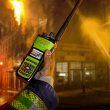Microwave path design: The basics
Part 2 -This four-part primer on propagation-related basics, for those learning about microwave communications, continues with a discussion of path clearances and Fresnel zones.
In Part 1 of this series (MRT May), two of the basic propagation-related considerations in the microwave path design process were discussed: * determining whether a proposed path is "line-of-sight." * evaluating path clearances with regard to refractive effects.Remaining fundamental design components to be discussed are: * evaluating path clearances with regard to Fresnel zones. * considering path reflections. * deriving a power budget and the fade margin. * path reliability.
This article will briefly cover item three, path clearances and Fresnel zones. The remaining items will be dealt with in the concluding parts of this series.
Evaluating path clearances-Fresnel zones
If one were to look directly into the center beam of a microwave path (gazing directly into the dish), the Fresnel zones could be defined as an infinite number of circles centered around the center beam, each having a larger radius than the previous one, as shown in Figure 1 below. The Fresnel zones get closer as they expand further away from the center. The radii of these zones reach a maximum at mid-path and diminish on either side of mid-path.
>From a side view of the path, as shown in Figure 2 on page 30, one can see the creation of ellipsoids between path endpoints, centered around the main beam. Each ellipse represents the boundary of a particular Fresnel zone.
Fresnel zones are numbered from the center of the path out. The boundary of the first radius out from the center represents the first Fresnel zone, which contains all wave components whose distance traveled to the far-end is exactly 1/2 wavelength (l)greater than the direct ray. The boundary of the second radius out from the center represents the second Fresnel zone, which contains all wave components whose distance traveled to the far-end is exactly 1l greater than the direct ray. Each integer increase of Fresnel zone number represents an increase of 1/2l to the distance traveled to reach the other end of the path.
The equation that determines the radius of the first Fresnel zone (in feet) at any particular distance along the path is:
F[sub-one] = 72.1 X SQR (([sub-one] X d[sub-two]/(f X D))
where F1 = the first Fresnel zone radius (ft.). d1 = distance (mi.) from one endpoint to the point being considered. D = total path length (mi.). d2 = D 2 d1. f = frequency (GHz).
The radius of any Fresnel zone number can be calculated by the following equation once the radius of the first Fresnel zone has been determined: F[sub-n]= F [sub-one]X SQR(n)
where n = the Fresnel zone number being evaluated.
When examining path profiles, if one wishes to know what Fresnel zone is represented by a particular clearance (in feet), the following form comes in handy: Frenzel zone # = clearance^2(ft.) X F X D/ 72.1^2 X d [sub-one] X d [sub-two]
In general, if the path is line-of-sight with adequate clearance, the loss in RF signal between one end's transmitter and the other end's receiver will merely be that of free space, as described by the equation:
FSL (dB) = 96.6 + 20 log10 F + 20 log10 D
Where
FSL (dB) = Free Space Loss (dB).
F = Frequency (GHz).
D= Distance (mi.).
As indicated in Figure 3 on page 32, if a path has less than 0.6 first Fresnel zone clearance, there will be more loss than merely that of free space, even though a line-of-sight condition may exist. With odd Fresnel zone clearances something less than free space losses may be realized, while with even Fresnel zone clearances losses may be quite significant. This is because of the phase relationship between the direct and reflected signal at the receiving antenna.
When the signal is reflected, it undergoes a 1808 phase lag (equivalent to 1/2l delay) referenced to the incident wavefront. (Although, as will be mentioned in Part 3 of this series, wave polarization and grazing angle can affect this). If the reflective surface is located at the first Fresnel zone, the reflected signal will arrive at the receiver delayed by another 1/2l, for a total delay of 1l. Signals reaching the receive antenna are therefore in phase and additive.
If the reflective surface is located at the boundary of the second Fresnel zone (which by definition, delays the signal by two 1/2 wavelengths) the wavefront, when reflected, reaches the receiving antenna delayed by a total of 1.5l. This means it will be out of phase relative to the incident wavefront, and signals reaching the receiver will cancel to some extent.
This effect repeats for each odd and even Fresnel zone, which explains the slight rises and very deep nulls in signal level for the even and odd Fresnel zone clearances (as shown in Figure 3). Raising one or both antennas is one method of altering the Fresnel zone clearance. As the clearance increases to higher order Fresnel zone numbers, the intensity of this problem diminishes because the magnitude of the coefficient of reflection with regard to the reflecting surface diminishes.
Paths are usually designed to meet specific Fresnel zone clearance criteria for one or more values of K. "Heavy route" requirements dictate that there must be at least 0.3 first Fresnel zone clearance when K 5 2/3, and 1.0 first Fresnel zone clearance when K 5 4/3, whichever is greater. "Light route" requirements dictate at least 0.6 first Fresnel zone clearance plus ten feet when K 5 1.
Another important consideration here is what type of reflecting surface is being evaluated. In general, three categories of surfaces are defined, each with its own reflection coefficient: R 5 0 (a sharp or "knife" edge), R 5 20.3 ("average" roughness) and R 5 21.0 (a smooth spherical surface). (The reflection coefficient will be described in more detail in the third article of this series.) The type of surface makes a big difference with regard to attenuation on the even Fresnel zone clearances because obstructions with larger, smoother surface areas reflect more energy. With more out-of-phase reflected energy combining with the incident signal at the receiver, greater cancellation of RF receive signal will be realized, resulting in deep fades as shown in Figure 3.
The next article in this series will briefly discuss path reflections, the power budget and the fade margin.
Read More:
References Laine, R.U., Determining Antenna Heights for Coastal Areas, Lenkurt Electric, Monograph 197.
"Microwave Systems, Microwave Path-Testing," Bell Systems Practices, AT&T Standard, September 1962.
"Microwave Transmission Engineering (Part One and Two)," GTE-Lenkurt Demodulator, July/August, 1972.
White, R.F., Engineering Considerations for Microwave Communications Systems, 4th Ed., GTE-Lenkurt, San Carlos, CA, 1983.
















